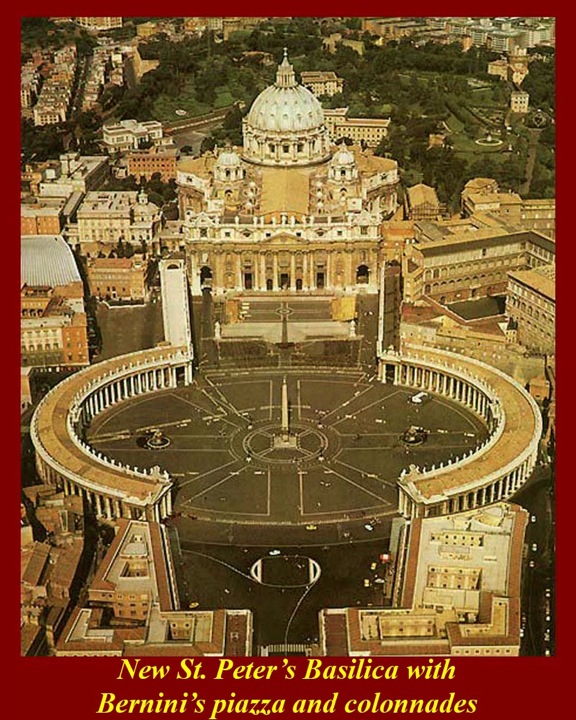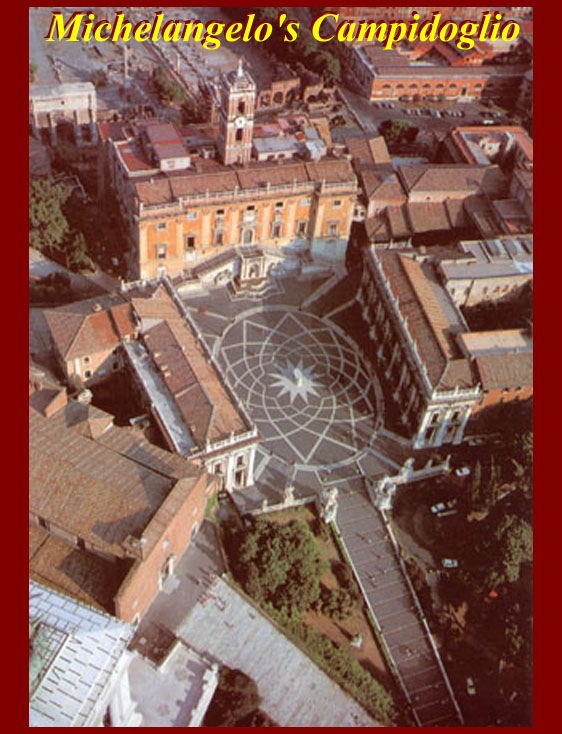Renaissance Rome Unit 06 -- Architecture
This is http://www.mmdtkw.org/RenRom0600-ArchitectIntro.htm
Renaissance Roman Architecture
As was the case with other aspects of the Renaissance, Roman Renaissance architecture was "different" in that it was centered on Religion. Family ambition was aimed at procuring Cardinals' hats -- maybe even a Papal tiara later -- and most of Rome's grand structures were part of these ambitious programs. As in Ancient Roman times, the social, political, and religious organization was based on patronage, and, in particular, the ancient institution of the "familia" (Italian , "famiglia") was revived. All of the "old" families and the new merchant and immigrant families wanted to have appropriate structures to in which to house their higher level clientage.
Some Medieval structures survived into the Renaissance (in fact, much of the Trastevere district and some of the Campus Martius are still Medieval) but large areas were built over -- or built into Renaissance Palazzo compounds. In addition, some areas inside the walls that had been unused since ancient times were now rebuilt with huge Renaissance residential buildings.
Campidoglio:
Civic buildings were not neglected. The saddle between the two peaks of the Ancient Roman Capitoline Hill, which throughout the Medieval period had been a civic center, was rebuilt over a period of centuries with grand new Renaissance civic palaces following an architectural plan drawn up by Michelangelo. Although not as large as the Vatican compound pictured above, Rome's new civic center buildings were no less impressive. (Note that the pavement in the central Piazza was not completed until 1930 -- black reversed for white, but precisely according to Michelangelo's plan.) The central building with the Medieval clock tower is the Palazzo Senatorio, Rome's city hall, and the two buildings on the side of the Piazza are the Campidoglio Museums, both of which were completely renovated during the 1990s
Religious buildings -- churches and oratories -- were also rebuilt or renovated and expanded during the Renaissance, and some new churches were built. The biggest project was, of course, St. Peter's in the Vatican, which was completely rebuilt. There was strong local feeling to preserve the "Old St. Peters", the Constantinian basilica, but if was soon clear that centuries of neglect had brought it to a unrepairable state. The replacement process took generations to complete -- both of popes and of architects -- but it was once again Michelangelo's plan for the new St.Peter Basilica that was eventually followed. Bernini's grand curving colonnades were added toward the end of the process.
S. Maria Maggiore evolved as a new fašade and loggia were added. The Lateran Papal compound was greatly changed -- the church vastly expanded and the old Lateran Palace rebuilt on a smaller scale after the old structure was ravaged by fire and after the new "Apostolic Palace" was built in the Vatican. Bernini and Borromini were among a group of architects who designed new churches, but it was those two who ushered in the new "Baroque" architecture, the last wave of Roman and Italian Renaissance architecture that washed over Europe. Invariably, the patrons of church construction, whether rebuilt, expanded, or new, were the same families (famiglie) that built the grand palazzos, and in many cases the churches were actually incorporated in the palazzos.
Topics for discussion
Some of the millions of Internet links for Roman Architecture (the best way to find something is to use your Internet search engine and search for Rome, architecture, and the name of the structure or architect.) Great Italian Renaissance Architects How Medieval evolved into Renaissance
Housing the familia
The Campidoglio
The Eclesiatical Familia Residences
St. Peters and the Vatican
Churches
General Roman Renaissance Architecture links
http://www.mmdtkw.org/arch.html
http://www.romeartlover.it/Rena.htm
http://www.romeartlover.it/Facades.html
http://www.loc.gov/exhibits/vatican/arch.html
Information on any of the artists listed below or on any other Roman Renaissance artists can be found with a search at http://images.google.com/imghp.
Berninihttp://www.kfki.hu/~arthp/bio/b/bernini/gianlore/biograph.html
http://rubens.anu.edu.au/htdocs/bycountry/italy/rome/popolo/midjpg/alphabetical/index15.html
Borromini
http://www.artble.com/artists/gian_lorenzo_bernini
http://www.bluffton.edu/~sullivanm/carlo/carlo.html
http://www.math.nus.edu.sg/aslaksen/projects/perspective/spada.htm
Bramante
http://www.newadvent.org/cathen/02736a.hthttp://www2.siba.fi/~kkoskim/rooma/pages/PCANCELL.HTM
http://www.romeartlover.it/Vasi74.html
http://members.tripod.com/romeartlover/Juv3.html
Campidoglio
http://www.romeartlover.it/Vasi80.htm
http://www2.siba.fi/~kkoskim/rooma/pages/PCAMPIDO.HTM
Paladio
https://en.wikipedia.org/wiki/Andrea_Palladio
Pictures for this Unit are on the Internet at

